The 1960 half dollar is a coin struck by the United States Mint in 1960. It is made of silver, and as an old coin, it carries a great deal of premium. Thus, you might be interested in getting a 1960 half dollar and adding it to your collection. If you wish to learn more, read the rest of this article.
What Is the 1960 Franklin Half Dollar Made Of?
The 1960 Franklin half dollar is made of 90% silver and 10% copper. The US Mint issued this coin from 1948 to 1963. Here are other specifications you need to know:
- Value of 50 cents
- Mass of 12.50 grams
- Thickness of 1.8 millimeters
- Diameter of 30.61 millimeters
- Actual Silver Weight is 0.36169 troy oz
The obverse of the coin features the image of Benjamin Franklin, one of the founding fathers of the United States. On the reverse, you’ll find the Liberty Bell and an eagle.
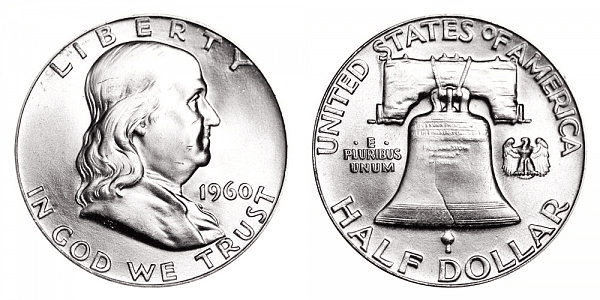
The former Mint Director Nellie Taloe Ross spearheaded the addition of Franklin to the half dollar coin. There have been a few controversies surrounding this idea. For one, many people knew that Franklin didn’t like putting portraits of prominent people on a coin. For Franklin, it is better to add a proverb to a coin rather than an image of a person.
Aside from that, if Franklin had been alive, he wouldn’t like the idea of adding an eagle with his portrait on the half dollar. He was noted to be a practical man who would like more to have an image of a turkey on the coin rather than an eagle, which according to Franklin, is known to be a scavenger.
Moreover, the JRS on the half-dollar coin, which is the initials of John Sinnock, was seen to be a tribute to the Soviet Leader Joseph Stalin. Of course, Stalin didn’t have an R in his name.
Not only that, but the Commission of Arts disliked the design of the 50-cent coin presented to them.
These controversies didn’t stop the US Mint from retaining the Franklin design. Thus, the Franklin half dollar was born.
1960 Franklin Half Dollar Varieties
The 1960 Franklin half dollar varieties are essentially the same in design. The main difference is their mint mark, which indicates where the coin was struck.
The Denver and Philadelphia Mint worked together to produce more than 25 million half-dollar coins. The San Francisco Mint stopped making coins in 1955 and will only make coins again in 1964.
Here’s a quick look at the 1960 Franklin half dollar coin varieties and their mintage:
| Variety | Mint Location | Mintage |
| 1960 D Franklin Half Dollar | Denver | 18,215,812 |
| 1960 P Franklin Half Dollar | Philadelphia | 6,024,000 |
| 1960 Proof Franklin Half Dollar | Philadelphia | 1,691,602 |
| Total | 25,931,414 |
With that, let’s go through each of the 1960 Franklin half dollar varieties in greater detail.
1960 D Franklin Half Dollar
Year of minting: 1960
Mint Mark: D
Place of minting: Denver
Quantity produced: 18,215,812
Face Value: $0.50 (ten cents)
Price: $8.75 to $11.25 (circulated condition)
Mass: 12.5 grams
Edge: Reeded
Designer: John R. Sinnock
Composition: 90% Silver and 10% Copper
Diameter: 30.6 millimeters
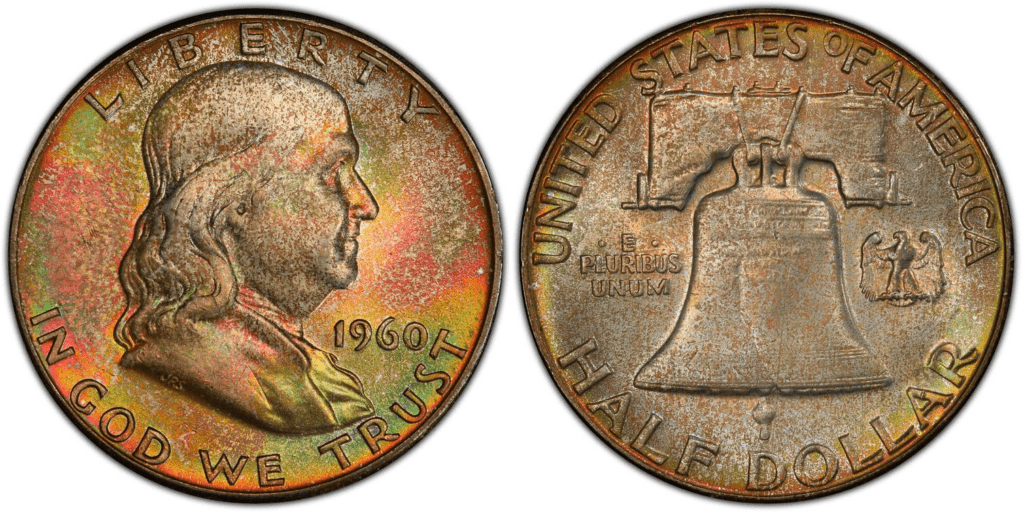
More than 18 million half dollar coins were struck by the Denver Mint in 1960. This mintage figure is higher than the mintage figure of 1959 but lower than that of 1961.
1960 P Franklin Half Dollar
Year of minting: 1960
Mint Mark: none
Place of minting: Philadelphia
Quantity produced: 6,024,000
Face Value: $0.50 (ten cents)
Price: $8.75 to $11.25 (circulated condition)
Mass: 12.5 grams
Edge: Reeded
Designer: John R. Sinnock
Composition: 90% Silver and 10% Copper
Diameter: 30.6 millimeters
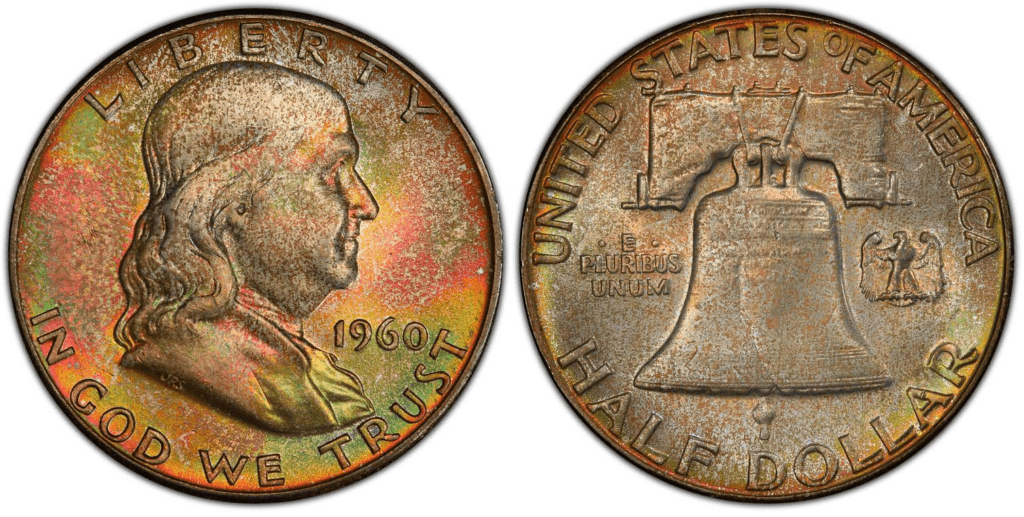
The Philadelphia Mint produced more than six million half-dollar coins, much fewer than in 1959 and 1961.
What’s notable about the 1960 P half dollar is that the coin was struck better than in the 1950s. The reason is that from 1952 to 1959, the Philadelphia Mint used a worn-off die. Thus, coins from these years will show you blurry hairlines on Franklin’s head. Starting in 1960, the die was restored, and now, it has a better and more detailed strike.
1960 Proof Franklin Half Dollar
Year of minting: 1960
Mint Mark: none
Place of minting: Philadelphia
Quantity produced: 1,691,602
Face Value: $0.50 (ten cents)
Price: $24 or more (uncirculated condition)
Mass: 12.5 grams
Edge: Reeded
Designer: John R. Sinnock
Composition: 90% Silver and 10% Copper
Diameter: 30.6 millimeters
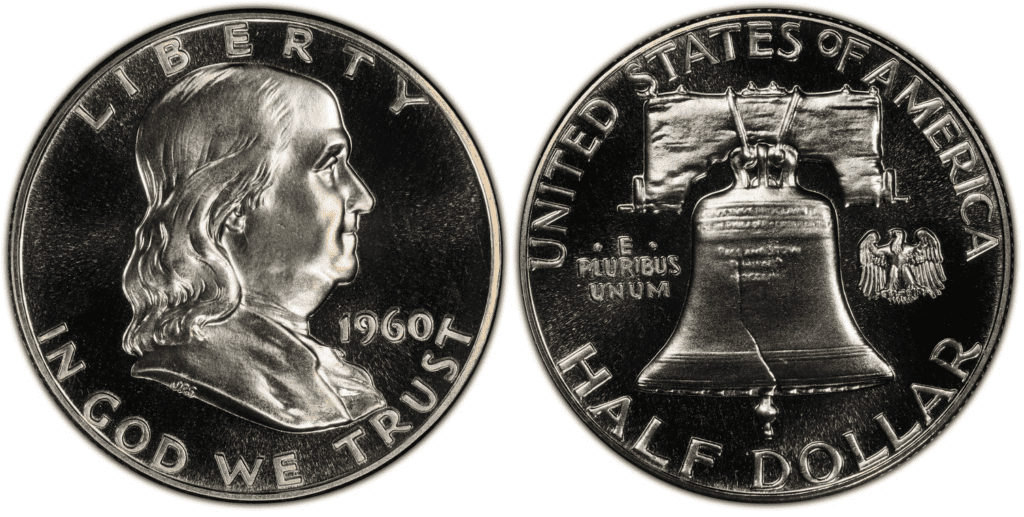
Aside from the regular coins, the Philadelphia Mint also produced 1960 Franklin proof half dollar coins. With over a million proof coins, it is obvious that more and more people are interested in getting beautiful half-dollar coins.
Proof half dollars are quite common up to grades of PR 68. However, proof half dollars with cameo surfaces are extremely scarce.
List Of 1960 Franklin Half Dollar Errors
There are different Franklin half dollar errors in the year 1960. Some of them were discovered later, while others were discovered earlier, which prevented further production of the same error.
Error coins happen due to mechanical errors. Sometimes, it can also be due to human error. Here are some examples of 1960 half dollar errors:
Strike-through error
The strike-through error happens not just on the half dollar but also on other US coins. This happens when a certain object gets stuck between the die and the planchet.
When the die strikes the planchet, the die strikes through foreign material, which leaves an unnecessary mark on the coin.
Here’s an example of a strike-through error:
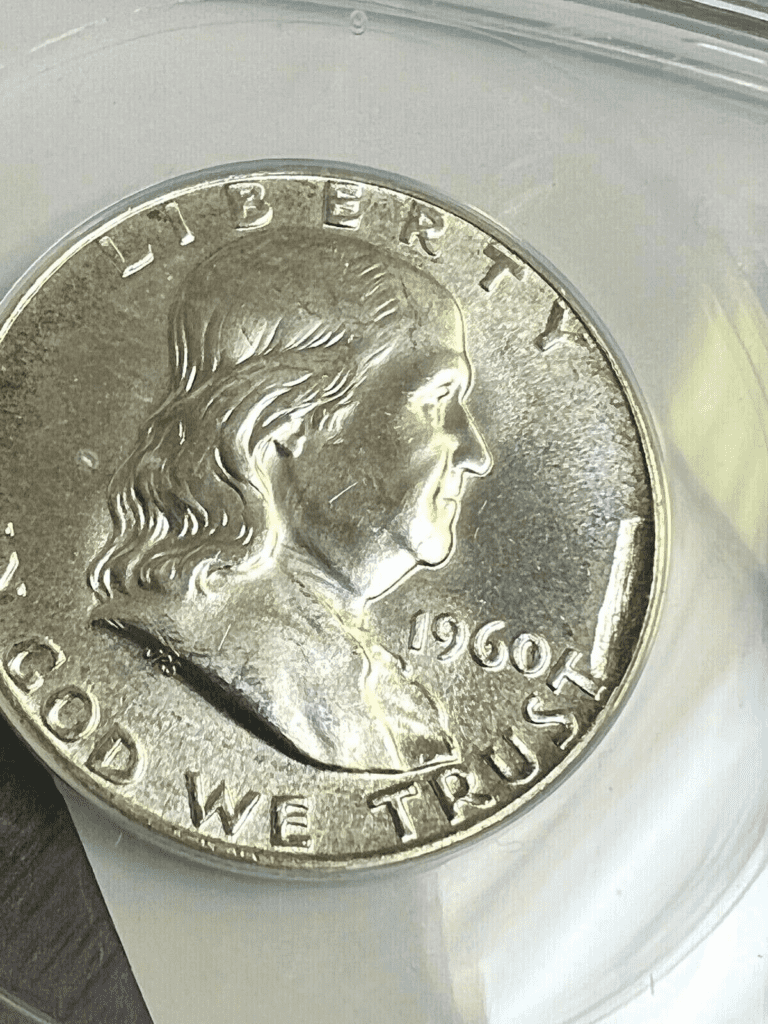
Notice the thick short line above the letter T in “TRUST.” A strike-through error causes that.
Doubled die error
The doubled die error happens when the die hits the planchet twice. This results in the doubling of engraved elements. Most doubled-die errors are not obvious, and you need a magnifying glass to see them. However, if a doubled die error is prominent, it can command a higher price.
Lamination error
Lamination error happens when a different metal or material gets into the mix of silver and copper. When the planchet cools down, the foreign material doesn’t mix well with the rest of the coin’s composition. This will then lead to cracking or peeling on the coin’s surface.
How Much Is 1960 Franklin Half Dollar Worth Today?
A circulated 1960 Franklin half dollar may start its price between $8.75 to $11.25. The melt value of this coin is also higher than its face value. The melt value is around $7.9067. It can go up or down, depending on the market value of silver.
The value of the 1960 Franklin half dollar can also become exponentially higher than its melt value or face value. To understand the potential value of a 1960 Franklin half dollar, here’s a table that shows their auction records:
| Coin | Condition | Grade | Sold date | Sold by | Value |
| 1952 P Franklin Half Dollar | Superb Gem Uncirculated | MS 67+ (Full Bell Lines) | August 10, 2016 | Heritage Auctions | $28,200 |
| 1952 Proof Franklin Half Dollar | Superb Gem Uncirculated | PR 69 (Deep Cameo) | January 1, 2008 | Heritage Auctions | $27,600 |
| 1952 D Franklin Half Dollar | Gem Uncirculated | MS 66 (Full Bell Lines) | May 1, 2003 | Heritage Auctions | $12,075 |
How Does The Grading System Work?
Coin grading is important for buying, selling, and collecting US coins. A standard is set to determine the condition of a coin so that all people can agree to the grades given to a specific coin.
A 1960 half dollar coin is graded based on its appearance, attractiveness, quality of strike, and color. Based on these criteria, the half dollar would be graded from 1 to 70.
Professional numismatists joined together in the 1970s and established CoinGrading standards. These numismatists now assign grades at key places on the seventy-point scale, using the most regularly utilized numeric points in conjunction with the original adjective grade. The following are the most common coin grades:
- (P-1) Poor – Indistinguishable and probably damaged; if used, must have a date and mintmark; otherwise, rather battered.
- (FR-2) Fair – Nearly smooth, but without the damage that a coin graded Poor often possesses. The coin must have enough detail to be identified.
- (G-4) Fair – Inscriptions have merged into the rims in some areas, and important elements have been mostly erased.
- (VG-8) Very Good- A little weathered, but all primary design elements are visible, albeit faintly. There is little, if any, central detail left.
- (F-12) Good – The item is very worn, yet the wear is even, and the overall design details stand out clearly. Rims are almost completely isolated from the field.
- (VF-20) Very Fine – Moderately weathered, with some finer features still visible. The motto or all letters of LIBERTY are readable. Both sides of the coin have entire rims separated from the field.
- (EF-40) Extremely Fine – Gently used; all gadgets are visible, and the most important ones are bold. The finer details are bold and clear; however, light wear may be seen.
- (AU-50) Uncirculated – Slight evidence of wear on the coin’s design’s high points; it may have contact marks; eye appeal should be adequate.
- (AU-58) Uncirculated Choice – Slight traces of wear, no severe contact marks, almost full mint shine, and great eye appeal.
- (MS-60) Mint State Basal – Strictly uncirculated; no indication of wear on the coin’s highest points, but an unsightly coin with reduced luster, visible contact marks, hairlines, and other flaws.
- (MS-63) Mint State Acceptable – Uncirculated, but with contact scratches and nicks, little reduced shine, but otherwise appealing appearance. The strike is weak to average.
- (MS-65) Mint State Choice – Uncirculated with great mint shine, little contact blemishes, and exceptional eye appeal. The strike is unusually severe.
- (MS-68) Mint State Premium Quality – Uncirculated with superb luster, no obvious contact marks to the naked eye, and exceptional eye appeal. The strike is quick and appealing.
- (MS-69) Almost Perfect Mint State – Uncirculated with perfect brilliance, a sharp and appealing strike, and extremely good eye appeal. A near-perfect coin with minor imperfections in the planchet, strike, and contact markings (seen only under 8x magnification).
- (MS-70) Mint State Perfect – Under 8x magnification, no tiny imperfections are discernible; the strike is crisp, and the coin is perfectly centered on a beautiful planchet. Rarely seen on a coin, this coin is bright and whole, with original luster and exceptional eye appeal.
For the half dollar coin, there’s also a specific designation given to it to indicate whether it is fully struck or partially struck. A coin with a Full Bell Lines designation means that the coin has a detailed strike and, thus, carries a higher premium.
Where To Buy Or Sell 1960 Franklin Half Dollar?
Here are some of the best places where you can buy or sell 1960 Franklin half dollar coins:
- Online marketplaces – there are a lot of online marketplaces that you can visit. Examples are Amazon, eBay, Etsy, and Facebook Marketplace. Aside from that, some websites specialize in selling or buying coins, such as Coin Appraiser, Grey Sheet, and USA Coin Book.
- Coin shops – find local coin shops near you. You can also try pawn shops and antique stores. While not always, they might still be able to sell you a 1960 Franklin half dollar. It’s worth a try.
- Auction houses – the most popular auction houses for US coins include Heritage Auctions and Stack’s Bowers. These auction houses are known to sell and buy rare and beautiful coins.
FAQs
Where is the mint mark on a Franklin Half Dollar?
The mint mark of a Franklin half dollar is found on the coin’s reverse side, just above the Liberty Bell’s yoke.
How much is a 1960 Ben Franklin half dollar worth?
Ordinary 1960 Franklin 50-cent coins may be around $8 to $12. However, an uncirculated 1960 Franklin half dollar can be worth thousands. For example, a 1952 P 50-cent with a grade of MS 67+ was sold for $28,200 in August 2016.
Is a 1960 half dollar silver?
Yes, the 1960 half dollar is made of silver with an Actual Silver Weight (ASW) is 0.36169 troy oz.
